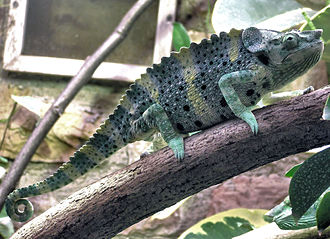Type the name of the breed you're looking for below
[wpdreams_ajaxsearchlite] Don't see the breed your're looking for? Click here and let us know!
Meller’s Chameleon
| Place of Origin and Range | Trioceros melleri, with the common names Meller's Chameleon and Giant One-horned Chameleon is the largest species of chameleon from the African mainland. Meller's Chameleon gets its common name from a "Dr. Meller" who is mentioned by biologist and taxon authority John Gray in the section about the habitat of the species in his 1865 description. |
| Description | Meller's Chameleon is stout-bodied and has a relatively stubby tail one third the length of its body. A low, scalloped crest extends from just behind the casque of the head through the proximal half of the tail, and a sharp medial crest runs from the lizard's eyes to the tip of its snout, which bears a single small horn. This chameleon bears greatly enlarged occipital lobes. It has heterogeneous scales which vary shape and size to various parts of its body and large, granular scales distributed homogeneously on the trunk and limbs. There are longitudinal rows of large, granular scales in the chameleon's gular region, one of its most distinctive characteristics. Spots and broad vertical bands on the chameleon's flanks range in colour from brown, dark green, yellow or even black. The basic colouration of the creature is a deep forest green with white stripes, but like many chameleons it can change its colour depending on various circumstances. If being fed or handled they might display black and white dots. When basking in the sun, the side of their body towards the sunlight can turn dark green or black, while the rest of the animal stays much lighter. Meller's Chameleon has colour patterns associated with stress. Mild excitement or stress is indicated by dark spotting overlaying the reptile's normal colour. These dark green spots turn to black mottling as the chameleon gets more upset. Severe stress turns the chameleon first charcoal grey, followed by pure white adorned with yellow stripes. A sick Meller's Chameleon may be mottled with brown, grey, pink, or white. A gravid animal is black, cream, and grey coloured and will be bulging with eggs. |
| Morph Patterns Available | Yes |
| Adult Size | Can grow up to 12 in (30 cm) |
| Accommodation | This chameleon lives in a number of habitat types in its native range, including plateaus, mountains, and valleys. Like other chameleons, it is arboreal, living in trees and other large plants. It prefers warmer temperatures, generally between 75° to 95°F (24° to 35°C). Also you want to include a bathing dish big enough for your chameleon to climb in without overflowing. To improve shedding. 2 ft x 2 ft x 4 ft terrarium for an adult. |
| Lifespan | Can live 2- 5 years |
| Feeding / Diet | Like most chameleons, Meller's are strict carnivores eating insects, smaller lizards, spiders, worms, and caterpillars. Large specimens have been known to eat small birds. |
| Breeding | A gravid animal is black, cream, and grey coloured and will be bulging with eggs. Females annually produce a single clutch of up to 80 eggs. Newborn Meller's Chameleons are about 4 inches (10 cm) in length and must be fed Drosophilidae and tiny crickets for the first three weeks of their lives. Afterwards, they accept house flies and larger insect prey including crickets, locusts, silkworms, and cockroaches. They may live as long as twelve years. |



